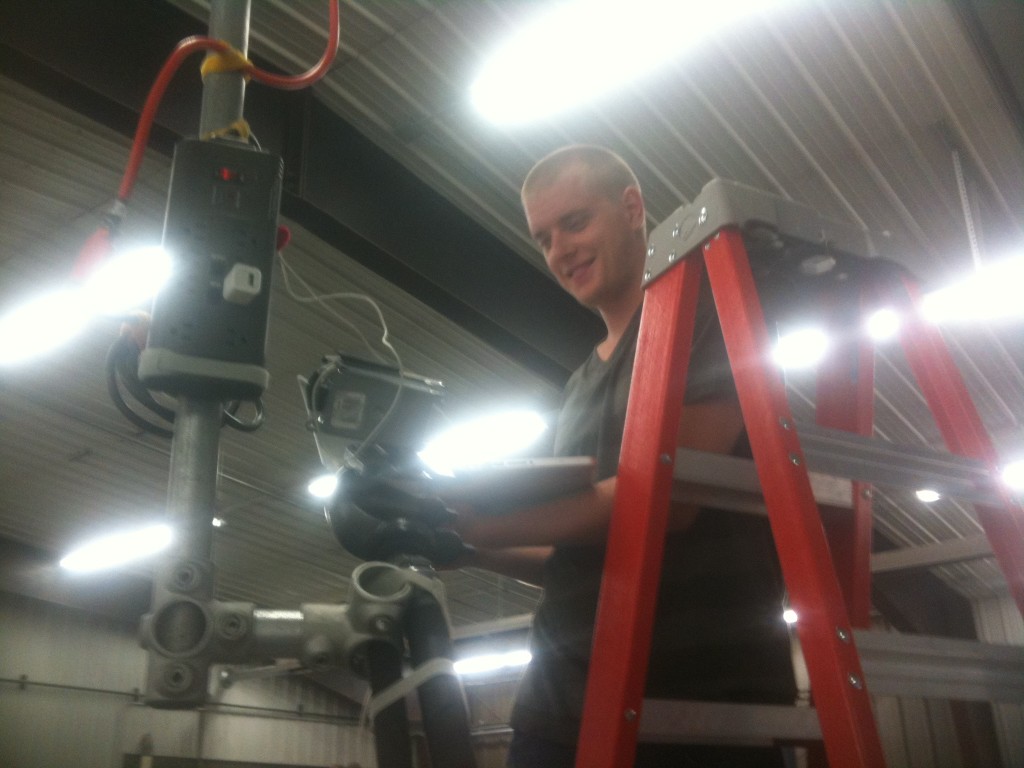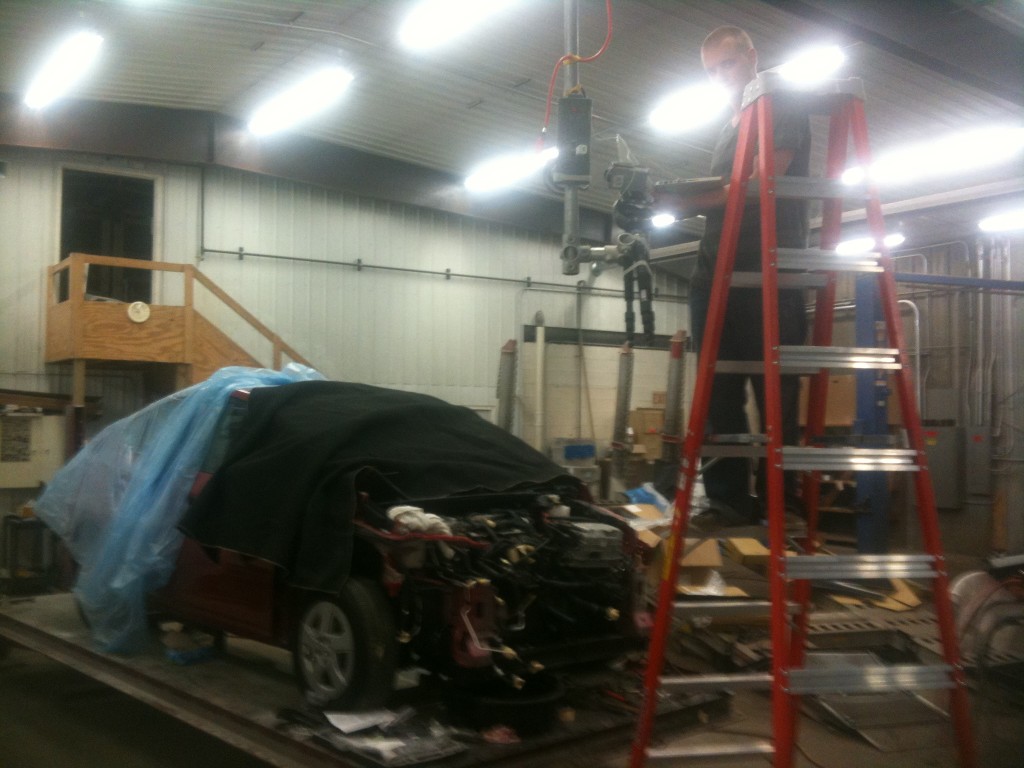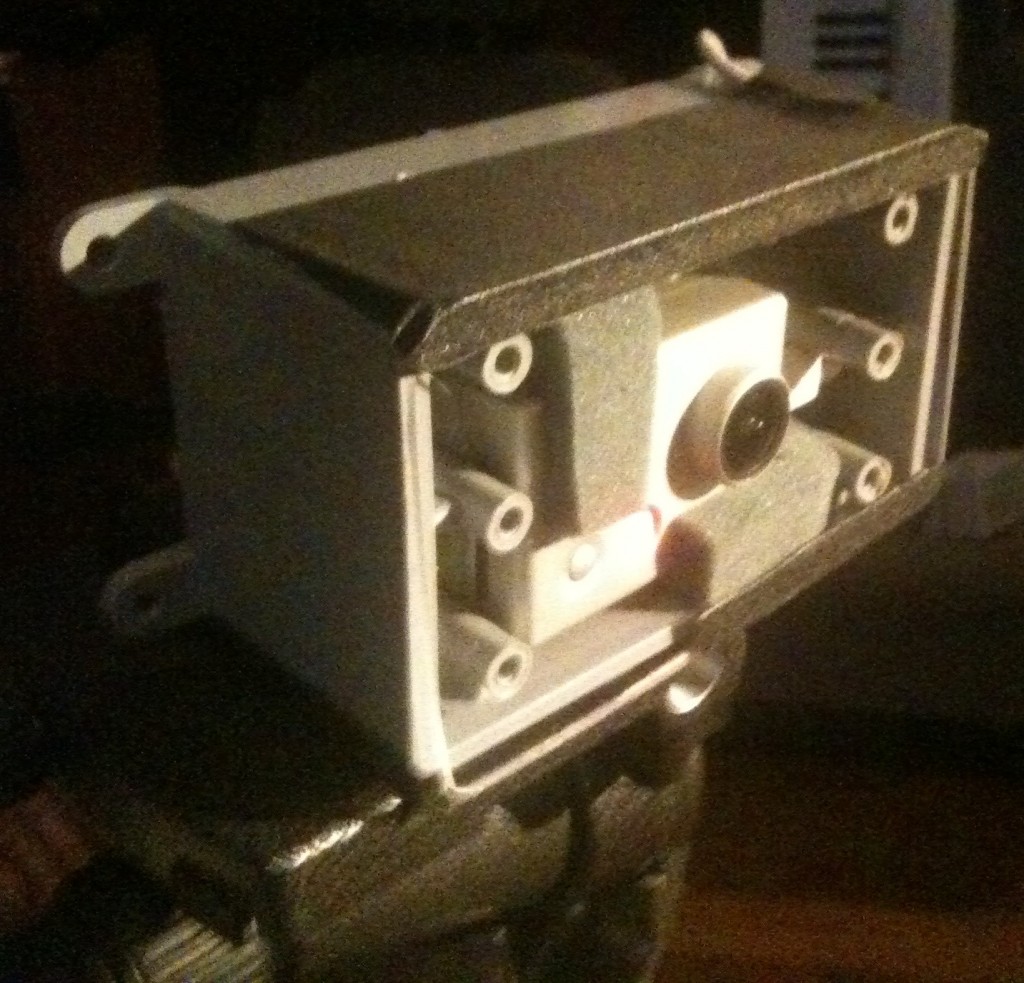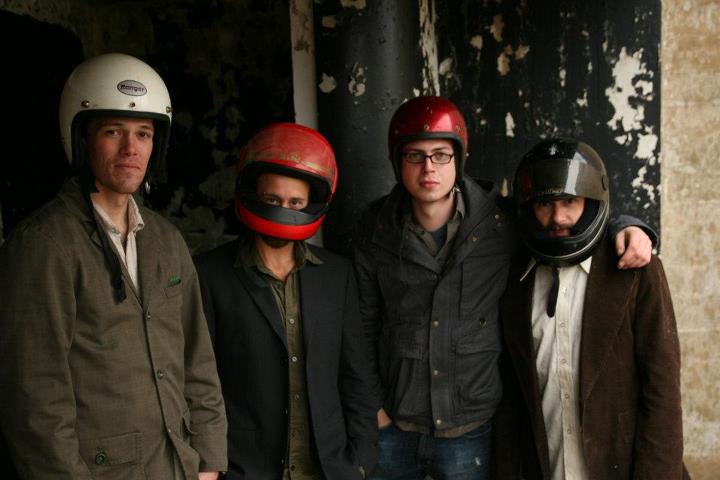Ben Woody rocks. As a summer intern for Trickster Pictures, Ben rotoscoped for DOG with zen-like concentration and produced a slew of personal bliss projects for YouTube. Towards the end of July, he proposed making a time lapse of his pal Danny Fox painting a car. Danny suggested that Camille and Reagan Frixen, his employers at Precision Collision might be willing to pay for this nutty scheme. When Ben brought the news back to the studio, I was slightly shocked to have my intern bird dogging clients… is there anything this guy can’t do?
Ben and I had just been talking about how a svelte production company like Trickster Pictures keeps the lights burning in Michigan’s smallest county and, more to the point, how making movies would support Ben after graduation next year. I was reluctant to get distracted from DOG, but taking on a short freelance project would give Ben the fundamentals of contracts, client negotiation, production on location, storytelling…
Knowing that time lapse was uncharted territory for a body shop, I proposed a doable day rate to the Frixens with all the post included. After Ben showed her a test shot, Camille wanted to do an entire car repair from start to finish – at least a week of shooting! This was a bigger commitment than I expected, but the die was cast… and the Frixens seemed very nice.
The following technical and logistical details about the project – though wittily recounted and replete with full color photo illustrations – are likely of interest to movie geeks only. Proceed at your own risk.
Ben handled camera set-up in the morning and pickup at closing time. We had also budgeted for a mid day camera change, which happened just twice.
The GoPro shoots an extreme wide angle, so the closer it’s placed to the subject the better. Since Precision Collision is a very busy shop, leaving a tripod set up in the middle of everything was not an option. We hung pipe from a garage door rail and floated the camera above the work area.
The pipe contraption. A tripod leg slides through the AIS clamp and fixed with velcro cable ties. Ben is checking the shot.
That pipe extends 7 feet to garage door rails and the ceiling of the shop is another 15 feet above that. AIS clamps and 1.25″ schedule 40 galvanized pipe made it happen.
The GoPro snapped a high resolution jpg every 2 seconds. A 32 meg HDSC card allowed for 7 hours of non-stop capture. The battery was only good for 2 hours th0, so I built a custom case and mount out of an electrical box. Like the standard case, it’s enclosed to protect the camera from dust and paint spray, but includes a USB cable for continuous power.
The improvised powered GoPro case and mount.
These two solutions were needed for success, illustrating the importance of being able to fabricate your way out of production challenges.
After the first day or two of jpgs were brought into After Effects, we plugged in a fabulous track from Fauxgrass. Stand up bassist Tim McKay said he’d check with the band about granting us a non-exclusive one time rights license. In late August I met the rest of the band at Alex and Meryl’s wedding and they were down. With Precision Collision, Ben Woody, Dan Kelly and now Tim McKay… that’s full, rich, Benzie flavor!
Fauxgrass is energetic, tight and way fun. I originally thought of using the track Chapel Pond, but I jumped on Maple Grove as a better match for the teleporting visuals and it’s affinity with Car Talk’s theme on NPR. Maple Grove was a slick fit even before I started tweaking.
Fauxgrass is Adam Balcer, Jason Wheeler, Joey Schultz and Tim McKay
The different instrumental sections suggested different days, so I timed each day to hit a transitions between sections. Reagan had requested that the spot welding be more visible, so I slowed the welding down and matched it to sweet banjo riff. Skads of synergistic moments were just begging to be teased out.
Ben imported the thousands of jpgs as sequences into After Effects. The uncut comps containing all the days’ sequences were brought into yet more comps and edited to include only moments when work was actually happening. These “cutdown” or edited comps included an expression to display the timecode for a running “total time on task”. Each new day had to have the previous days’ hours added on, and as I am hardly expression fluent not only did I have to do this manually but the precise values were discovered through trial and error – nudging the value up or down to get the new day’s timer one frame past the end of the previous day, gak!
I’m also rather annoyed to report that basic math knowledge has been deleted from my cogniverse. I was pretty bleary on the relationship between comp time and real time, not sure if the following scans even now…
To play back the action at the same time scale as it was captured, we’d display 1 jpg every 2 seconds or .5 jpgs every 1 second. So in 30 seconds, we’d display 15 jpgs. Meanwhile, our cutdown comps are displaying 30 jpgs every second, so here’s the question… How much real time has elapsed after 1 second of comp time?
1 second of real time play = .5 jpgs displayed
1 second of comp play = 30 jpgs displayed
First, here’s a more familiar example in miles per hour…
20 miles/hr x 10 hr = 200 miles
Substituting jpgs and seconds…
.5 jpgs/sec x b secs = 30 jpgs, so b = 60 seconds.
1 second of comp time represents 60 seconds (1 minute) of real time – in theory. In application 1 second of comp time seems to almost 2 minutes of real time. On the first day of shooting Reagan stuck a big analog clock (with hands) in the shot. When compared, the actual clock time varied from the comp time, about 1.8x. I made sure all the sequences were 30 fps and all the comps are 30 fps, not 29.98. I can only assume the GoPro rate of capture might wander a bit from 1 jpeg every 2 seconds or that I am missing something really obvious. Anyway I fudged the expression, multiplying the time by 2 to get a total of 26 hours for the whole job. They billed the client for 25 hours. Close enough.
This irks me actually, I want to stand behind my work but I have no idea what’s going on. There’s only so many hours in a day and I’ve sunk enough into this little project. The “total time on task” is an estimate and I’m moving on. That’s a hard decision, but it’s based on the budget for this project, my current level of expression expertise AND the expectations of the client. I’m down with deferring to their invoice, but ultimately I’d like to know what’s going on. Further research is going to have to wait, maybe Ben take a crack at it from Kalamazoo zoo zoo zoo.
I guess this is a teachable moment, tuning my obsessive perfectionism to align with what’s reasonable. I’ve written about this before, yes? 80/20, perfection rejection, the quest for good enough?
The 7th day we gathered finishing footage. Under a scudding sky Reagan and I did 8 or so takes of the Prius pulling out, trying for decent light. We finally got a workable take, opened the doors and tried some pans across the immaculate interior. By the time we finished there was plenty of sunshine. Rather shyly, Reagan wondered if we might do another take of the Prius pulling out. I thought that was funny because he got sucked into the mad quest for perfection. Making movies is contagious.
Meanwhile, Ben had the GoPro grabbing a time lapse of clouds passing over the sign. We also shot some additional time lapse approaching and driving around the shop.
Ben got fairly comfortable with After Effects, editing the days and assembling the master comp. I finessed the concept – timer, titles for each guy and his process. After he went back to school I assembled all the chunks.
There were plenty of puzzles to solve. I had to bury the white text of the timer within the cutdown comps. That meant that when I color corrected each day, the timer got tinted too, light purple or blue. The easiest fix was to tint the rest of the text to match, which made it all appear white again – gotta love perception.
Another finesse was cleaning up the Precision Collision sign from Ben’s cloud time lapse. There were some serious red stains in the letters which I didn’t mind (they’ve been in business for awhile) but the white wanted to be a little cleaner. I duplicated the layer, masked off the white text and color corrected.
I also had to slow the clouds down so they’d run through the entire credit roll. This made them a little stuttery. Applying motion estimation created a crazy distortion when the sun flickered across the sign. I duplicated and masked off the sky and shut down motion estimation on the sign.
I added a little story about the deer to emphasize the Benzie theme. Precision Collision plus Fauxgrass is an unlikely pairing, and what is Benzie anyway but an idea? It’s geography, the smallest county, a bunch of hicks and a whacky boom and bust resort economy. Yet, there’s something magic here. This video was a chance for me to talk about that, to launch a little manifesto. It’s not boosting exactly, more like flying our freak flag.



